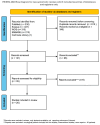Incidence and Prevention of Vaginal Cuff Dehiscence After Laparoscopic and Robotic Hysterectomy in Benign Conditions: An Updated Systematic Review and Meta-Analysis
- PMID: 40282938
- PMCID: PMC12028423
- DOI: 10.3390/medicina61040647
Incidence and Prevention of Vaginal Cuff Dehiscence After Laparoscopic and Robotic Hysterectomy in Benign Conditions: An Updated Systematic Review and Meta-Analysis
Abstract
Background and Objectives: Vaginal cuff dehiscence (VCD) represents a rare but relevant complication that occurs following minimally invasive hysterectomy. With the rising frequency of this procedure, it is crucial to continuously evaluate VCD incidence, risk factors, and prevention strategies. This systematic review and meta-analysis aimed to update the evidence on VCD incidence and to assess the role of various surgical techniques and materials adopted for vaginal cuff closure. Materials and Methods: A systematic literature search was conducted in PubMed, Scopus, Web of Science, EMBASE, and the Cochrane Library for studies published up to January 2025. Eligible studies reported VCD rates after laparoscopic or robotic hysterectomy for benign conditions and compared different closure techniques. The primary outcome was the incidence of VCD across closure methods, while secondary outcomes included potential risk factors. A random-effects model estimated pooled VCD rates with 95% confidence intervals (CI), and heterogeneity was assessed using I2 tests. Results: Twenty-six studies involving 10,039 patients were analyzed. The overall pooled incidence of VCD was 0.7% (95% CI: 0.4-1.1%), with higher estimates in randomized controlled trials (RCTs) (1.4%) compared to non-RCTs (0.5%). Robotic-assisted hysterectomy had a pooled VCD rate of 1.7%, compared to laparoscopic hysterectomy at 0.7%. Although not statistically significant, transvaginal closure showed a higher VCD risk than laparoscopic closure (2.3% vs. 1.16%; OR 0.97, 95% CI, 0.33-2.82; OR 2.53 (95% CI, 1.10-5.82) when considering only RCTs), and barbed sutures showed a lower VCD incidence (0.35%) than conventional sutures (1.52%) (OR 0.37, 95% CI, 0.13-1.02). Smoking was identified as a significant risk factor for VCD, while the impact of early postoperative sexual activity remains inconclusive. Conclusions: Laparoscopic closure rather than transvaginal cuff closure and barbed sutures were neither significantly associated with reducing VCD risk. Emphasizing smoking cessation preoperatively is essential for VCD prevention. Future studies should investigate the effects of postoperative sexual activity and refine surgical techniques to minimize VCD risk and improve outcomes.
Keywords: hysterectomy techniques; postoperative care; surgical outcomes; vaginal cuff closure.
Conflict of interest statement
The authors declare no conflict of interest.
Figures







Similar articles
-
Surgical approach to hysterectomy for benign gynaecological disease.Cochrane Database Syst Rev. 2015 Aug 12;2015(8):CD003677. doi: 10.1002/14651858.CD003677.pub5. Cochrane Database Syst Rev. 2015. Update in: Cochrane Database Syst Rev. 2023 Aug 29;8:CD003677. doi: 10.1002/14651858.CD003677.pub6. PMID: 26264829 Free PMC article. Updated.
-
Barbed suture in minimally invasive hysterectomy: a systematic review and meta-analysis.Arch Gynecol Obstet. 2015 Sep;292(3):489-97. doi: 10.1007/s00404-015-3653-x. Epub 2015 Feb 21. Arch Gynecol Obstet. 2015. PMID: 25700658
-
Comparison of the incidence of vaginal cuff dehiscence by hysterectomy route and type based on experienced surgeons' outcome.Int J Gynaecol Obstet. 2025 Jul;170(1):222-232. doi: 10.1002/ijgo.16189. Epub 2025 Feb 1. Int J Gynaecol Obstet. 2025. PMID: 39891484
-
Vaginal cuff closure after minimally invasive hysterectomy: our experience and systematic review of the literature.Am J Obstet Gynecol. 2011 Aug;205(2):119.e1-12. doi: 10.1016/j.ajog.2011.03.024. Epub 2011 Mar 22. Am J Obstet Gynecol. 2011. PMID: 21620360
-
Minimally invasive surgical techniques versus open myomectomy for uterine fibroids.Cochrane Database Syst Rev. 2014 Oct 21;2014(10):CD004638. doi: 10.1002/14651858.CD004638.pub3. Cochrane Database Syst Rev. 2014. PMID: 25331441 Free PMC article.
References
-
- Mehta A., Xu T., Hutfless S., Makary M.A., Sinno A.K., Tanner E.J., Stone R.L., Wang K., Fader A.N. Patient, surgeon, and hospital disparities associated with benign hysterectomy approach and perioperative complications. Am. J. Obstet. Gynecol. 2017;216:497.e1–497.e10. doi: 10.1016/j.ajog.2016.12.020. - DOI - PMC - PubMed
-
- Uccella S., Ceccaroni M., Cromi A., Malzoni M., Berretta R., De Iaco P., Roviglione G., Bogani G., Minelli L., Ghezzi F. Vaginal Cuff Dehiscence in a Series of 12,398 Hysterectomies: Effect of Different Types of Colpotomy and Vaginal Closure. Obstet. Gynecol. 2012;120:516–523. doi: 10.1097/AOG.0b013e318264f848. - DOI - PubMed
Publication types
MeSH terms
LinkOut - more resources
Full Text Sources
Medical

